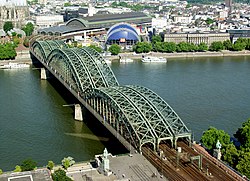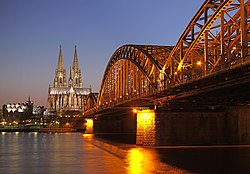This article has multiple issues. Please help improve it or discuss these issues on the talk page. (Learn how and when to remove these messages)
|
Hohenzollern Bridge Hohenzollernbrücke | |
|---|---|
 Hohenzollern bridge | |
| Coordinates | 50°56′29″N 06°57′56″E / 50.94139°N 6.96556°E |
| Carries | Train and pedestrian traffic[1] |
| Crosses | River Rhine[1] |
| Locale | Cologne, North Rhine-Westphalia, Germany[1] |
| Owner | Deutsche Bahn |
| Characteristics | |
| Design | Tied arch bridge (1948)[1] |
| Material | Concrete piers with steel superstructure[1] |
| Total length | 409.19 metres (1,342.5 ft)[1] |
| Width | 26.2 metres (86 ft) (deck, 1987)[1] |
| Longest span | 167.75 metres (550.4 ft)[1] |
| No. of spans | 118.88 metres (390.0 ft) - 167.75 metres (550.4 ft) - 122.56 metres (402.1 ft) (1987)[1] |
| History | |
| Constructed by | Krupp Maschinen- und Stahlbau (steel), Grün & Bilfinger and Heinrich Butzer (concrete) 1946 August Klönne and Stahlbau Albert Liesegang (steel), Philipp Holzmann AG (concrete) 1956 Hein, Lehmann & Co. and Krupp Industrietechnik GmbH and Thyssen Engineering GmbH (steel) 1986[1] |
| Construction start | 1946, 1956, 1986 |
| Construction end | 1948, 1959, 1987 |
| Construction cost | DM 14,000,000[1] |
| Location | |
 | |
Hohenzollern Bridge Hohenzollernbrücke | |
|---|---|
 Hohenzollern Bridge, with Cologne Cathedral and Museum Ludwig in the background | |
| Coordinates | see above |
| Crossed | River Rhine |
| Locale | Cologne, North Rhine-Westphalia, Germany[2] |
| Preceded by | Cathedral Bridge |
| Characteristics | |
| Design | Arch bridge with suspended deck (1911)[2] |
| Width | 32.45 metres (106.5 ft) (deck)[2] |
| Longest span | 167.75 metres (550.4 ft)[2] |
| No. of spans | 118.88 metres (390.0 ft) - 167.75 metres (550.4 ft) - 122.56 metres (402.1 ft) (1911)[2] |
| History | |
| Architect | Franz Heinrich Schwechten (1911)[2] |
| Construction start | 1907 |
| Construction end | 1911 |
| Collapsed | 6 March 1945[2] |
The Hohenzollern Bridge (German: Hohenzollernbrücke) is a bridge crossing the river Rhine in the German city of Cologne (German: Köln). It crosses the Rhine at kilometre 688.5. Originally, the bridge was both a railway and road bridge. However, after its destruction in 1945 and subsequent reconstruction, the bridge has been only accessible to rail and pedestrian traffic.
It is the most heavily-used railway bridge in Germany with more than 1,200 trains crossing daily,[3] connecting the Köln Hauptbahnhof and Köln Messe/Deutz stations.
- ^ a b c d e f g h i j k Hohenzollernbrücke (1987) at Structurae
- ^ a b c d e f g Hohenzollernbrücke (1911) at Structurae
- ^ DB Bahn: Hauptbahnhof Köln – Drehkreuz des Westen (in German)